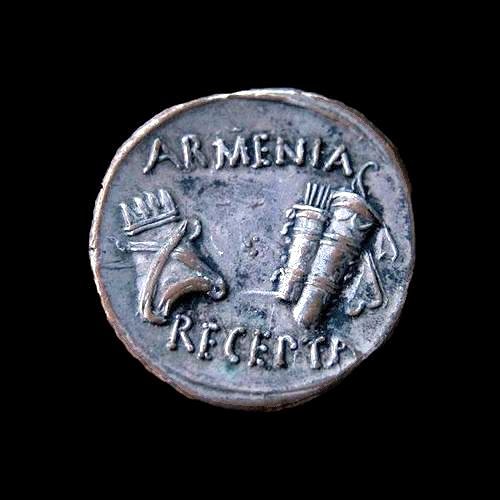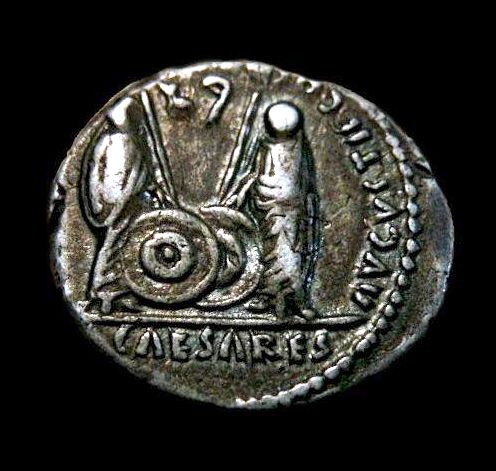

AR denarius 20 BC, Augustus 27 BC - AD 14 |
 |
 |
Gaius Octavius, of the gens Octavia, was named Gaius Julius Caesar Octavianus after 44 BC when he was posthumously adopted by his great-uncle Julius Caesar, whose will named him as heir. In 43 BC Octavian formed a triumvirate with Mark Antony and Lepidus. When Julius Caesar was deified in 42 BC, Octavian assumed the title divi filius (son of the deified Julius). He subsequently married Livia and became sole ruler in 31 BC when he defeated Antony and Cleopatra at Actium. In 27 BC Octavian returned government to the senate and formally restored the republic, however, he was designated the titles imperator (commander) and Augustus - a proclamation of his eminence in the state, a feature which became characteristic of imperial titulature on Roman coinage. Whereas under the republic the senate controlled state finances and the provision of coinage, Augustus exercised considerable influence over imperial financial institutions. His own private wealth provided him the authority to issue gold and silver coinage. Aes coinage was marked by the letters SC, a mere political gesture that indicated senatorial involvement - the senate authorised withdrawal of aes coinage from the aerarium). Obv. Augustus facing right, AVGVST. Rev. Armenian tiara, a bow case and a quiver, ARMENIA RECEPTA (Armenia regained). During the early years of Augustus' principate he emphasised his reputation as a successful general and references to imperial achievements characterise his coinage. During the civil unrest in Armenia a petition was sent to Augustus to appoint as ruler, Tigranes, brother of the late Artaxias. This reverse commemorates the successful campaigns of Augustus' adopted son Tiberius, who had installed a new king and had re-established Roman power in Armenia. Under Tigranes Armenia became a client kingdom of Rome. When Augustus died in Ad 14 Tiberius became emperor. |
AR denarius, Augustus c. AD 9 |
 |
 |
Coin portraits of Augustus always depict him with youthful idealised features and comma-shaped locks over the forehead even when he was in his seventies. A rare denarius of Mark Antony (41 BC) displays on the reverse the bare head of a youthful Octavian, depicted with a slight beard. From about 36 BC Octavian is portrayed without imperial titles, until 29 BC when his coinage took on the imperial characteristics displayed by his successors. These coins usually bear long legends on both sides. The image of the emperor, his name and titles adorned the obverse with the gods and personifications sharing the reverse. The portrait of the emperor was clearly regarded as a sign of supremacy. Whereas the portrait focused on the emperor, the reverse celebrated his eminence. Obv. Laureate head of Augustus right, CAESAR AVGVSTVS DIVI F. PATER PATRIAE - in AD 2 Augustus was accorded the honour of father of his country. The obverse shows strong Hellenistic artistic influence and depicts Augustus with accentuated and very dignified features. The emperor is wearing a crown of corn ears - an allusion to an ancient priestly guild in Rome. Rev. Gaius and Lucius Caesar togate, standing facing each other, with shields and spears between them, above, between the spears, are sacrificial implements. The simpulum represents Gaius, who became a pontiff in 7 BC, the lituus represents Lucius, who was appointed an augur. C. L. CAESARES AVGVSTI F. COS. DESIG. PRINC. IVVENT. This coin type was struck to celebrate Gaius and Lucius Caesar as heirs to imperial power. Gaius became princeps iuventutis in 5 BC; Lucius in 2 BC. Although they died in AD 4 and AD 2 respectively, coins comemmorating their elevation were issued until late in the reign of Augustus. |
| Republican | Imperatorial | |
Greek Imperial | Byzantine |